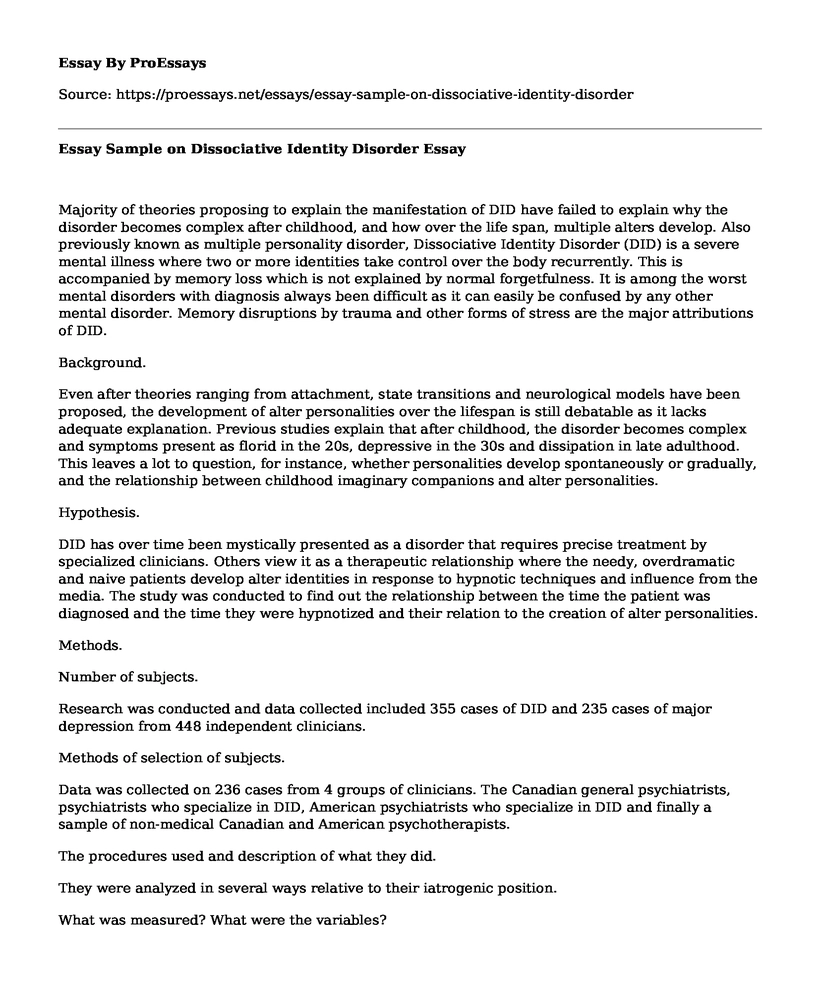Majority of theories proposing to explain the manifestation of DID have failed to explain why the disorder becomes complex after childhood, and how over the life span, multiple alters develop. Also previously known as multiple personality disorder, Dissociative Identity Disorder (DID) is a severe mental illness where two or more identities take control over the body recurrently. This is accompanied by memory loss which is not explained by normal forgetfulness. It is among the worst mental disorders with diagnosis always been difficult as it can easily be confused by any other mental disorder. Memory disruptions by trauma and other forms of stress are the major attributions of DID.
Background.
Even after theories ranging from attachment, state transitions and neurological models have been proposed, the development of alter personalities over the lifespan is still debatable as it lacks adequate explanation. Previous studies explain that after childhood, the disorder becomes complex and symptoms present as florid in the 20s, depressive in the 30s and dissipation in late adulthood. This leaves a lot to question, for instance, whether personalities develop spontaneously or gradually, and the relationship between childhood imaginary companions and alter personalities.
Hypothesis.
DID has over time been mystically presented as a disorder that requires precise treatment by specialized clinicians. Others view it as a therapeutic relationship where the needy, overdramatic and naive patients develop alter identities in response to hypnotic techniques and influence from the media. The study was conducted to find out the relationship between the time the patient was diagnosed and the time they were hypnotized and their relation to the creation of alter personalities.
Methods.
Number of subjects.
Research was conducted and data collected included 355 cases of DID and 235 cases of major depression from 448 independent clinicians.
Methods of selection of subjects.
Data was collected on 236 cases from 4 groups of clinicians. The Canadian general psychiatrists, psychiatrists who specialize in DID, American psychiatrists who specialize in DID and finally a sample of non-medical Canadian and American psychotherapists.
The procedures used and description of what they did.
They were analyzed in several ways relative to their iatrogenic position.
What was measured? What were the variables?
Hypnotizing patients was said to create multiple alters to DID patients. The number of alters varied according to the time the hypnotizing was done and the time the patient was diagnosed.
How did they measure this?
Patients were subdivided into three groups, patients who have never been hypnotized, patients who were hypnotized after diagnosis and patients who were hypnotized before and after diagnosis.
Results.
If hypnosis was responsible for the creation of alter personalities, the group that had been hypnotized prior to diagnosis should have demonstrated a greater number of personalities. No significant differences were found and therefore the influence of hypnosis to DID is inconclusive.
Conclusion.
As per the findings, it is important to note that hypnosis whether before or after diagnosis of DID is not responsible for creating any number of alter personalities. The study was unable to explain the causes of multiple personalities in a patient diagnosed with DID, and therefore any methods to find this out using hypnosis are inconclusive.
The article sheds light on the relation between age brackets and their possible number of alter personalities. The three alter personality stages are very well outlined, explaining the manifestations of each alter in each stage; also explaining possible causes of multiple alter personalities. However, the article assumes that DID will not develop in absence of imaginary companions, which is misleading as a person can only be diagnosed with DID if he/she presents with signs of having an alter personality. This article would have been more effective if the studies conducted linking hypnosis with diagnosis would have been done in different age groups.
References.
Pica, M. (1999) The evolution of alter personality states and dissociative identity disorder.Psychotherapy, 36(4) pg 404-405
Cite this page
Essay Sample on Dissociative Identity Disorder. (2021, Mar 23). Retrieved from https://proessays.net/essays/essay-sample-on-dissociative-identity-disorder
If you are the original author of this essay and no longer wish to have it published on the ProEssays website, please click below to request its removal:
- Analyzing Bullying Through Literature: Thirteen Reasons Why Essay
- Essay on History of Moral Philosophy
- Ethics: The Five Basic Principles Essay Example
- Research Paper on Role of Person's Mental Growth for Organization
- Essay on Unconditional Love Beyond Blood Ties: A Story of My Life
- Article Analysis Essay on Treatment Burden for Chronic Illness
- Free Report Example on Aphasia: Understanding the Neurolinguistic Disorder







